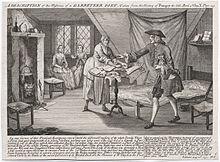
The novel of circulation, otherwise known as the it-narrative, or object narrative,[1] is a genre of novel common at one time in British literature, and follows the fortunes of an object, for example a coin, that is passed around between different owners. Sometimes, instead, it involves a pet or other domestic animal, as for example in Francis Coventry's The History of Pompey the Little (1751).[2] This and other such works blended satire with the interest for contemporary readers of a roman à clef.[3] They also use objects such as hackney-carriages and bank-notes to interrogate what it meant to live in an increasingly mobile society, and to consider the effect of circulation on human relations.[4]
- ^ Wolfram Schmidgen (2002). Eighteenth-Century Fiction and the Law of Property. Cambridge University Press. p. 127. ISBN 978-1-139-43482-9.
- ^ John Mullan (12 October 2006). How Novels Work. Oxford University Press. p. 149. ISBN 978-0-19-162292-2.
- ^ Liz Bellamy (26 September 2005). Commerce, Morality and the Eighteenth-Century Novel. Cambridge University Press. p. 121. ISBN 978-0-521-02037-4.
- ^ Ewers, Chris (2018). Mobility in the English Novel from Defoe to Austen. Boydell and Brewer. p. 101-102.